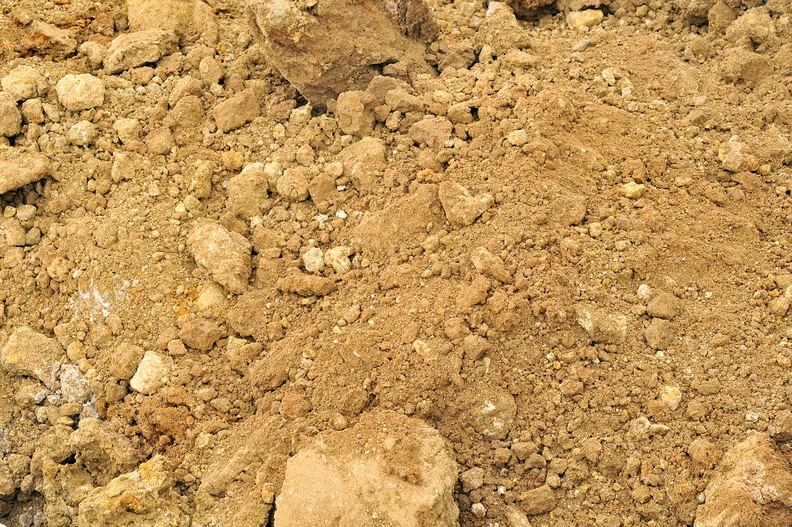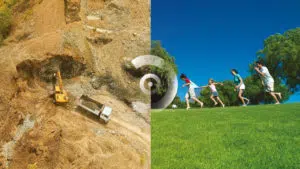ECT, a player in the circular economy of building and civil engineering soils
ECT’s development is part of a strategy of circular and local economy. ECT reuses inert soil from construction sites in the Paris region, working with local communities to create green, undeveloped and sustainable landscapes.
Some fifteen ECT projects are currently underway in the Paris region. Every year, they reuse almost 15 million tonnes of excavated soil.
The day-to-day management of these material flows raises questions about sustainable urban planning, urban metabolism, development and the attractiveness of territories.

The circular economy as proposed by ECT encourages the creation of positive loops.
What is the circular economy?
The French Environment and Energy Management Agency (ADEME) defines the circular economy as “an economic system of production which, at all stages of the product life cycle, aims to increase the efficiency of resource use and reduce environmental impact, while enhancing people’s well-being”.
This circular system therefore places the emphasis on new design methods, on extending the useful life of products, but also on use rather than possession of goods, on reuse and recycling.
Thus, the reuse of excavated soil from building and civil engineering sites for non-built development projects is an integral part of a circular economy model.
.
The ECT site at Villeneuve-sous-Dammartin (77) is emblematic of the reuse of excavated earth from the construction industry.
AM Filaire
Circular economy and urban metabolism?
To ask the question of how to control urban metabolism is to consider cities as “consumers” of materials and energy. Either produced directly on their territory, or indirectly through the materials, goods and services they import or export.
These material and energy flows traverse the urban ecosystem in a linear fashion. Upstream, resources are extracted from nature’s reservoirs. Then various urban activities exploit or transform them. And finally, downstream, they are returned to the ecosystem in degraded (or non-degradable) form. Cejecting waste materials affects the atmosphere, water and soil in a variety of ways. The impact on ecosystems and the biosphere in general is manifold.
Excavated soil is generated by the city’s necessary building activity. D’elsewhere, rLegally, these soils are considered as waste. And yet it’s a noble material, reusable and recyclable as is, provided it’s inert (unpolluted).
To give an order of magnitude, it is estimated that a region like Ile-de-France produces 22 million tonnes of excavated soil a year (excluding the construction of the Grand Paris Express).
How ECT promotes the circular economy of soil from construction sites
Reuse excavated soil
ECT’s circular economy approach provides a sustainable response to the need to reuse excavated soil locally.
The loops for reusing soil from construction sites are all development projects with an environmental or social vocation, designed and implemented by ECT.
Similarly, the reuse of soil to backfill and secure quarries in the Paris region encourages this circular use of soil.
The re-use of excavated soil makes the project self-financing.
Recycling derelict land
The reuse of excavated soil enables development projects to be financed in consultation with the local community. These projects give a new lease of life and a new use to damaged, neglected or derelict sites. This is a genuine recycling of unused land.
A circular, local loop
Finally, ECT’s vocation is to act locally, thanks to its network of reception and development sites.
The aim is to bring excavation sites closer to soil reception sites. Land reuse serves a local project.
The proximity of our sites limits the carbon impact of transport.
The reuse of excavated soil from the construction industry on the ECT site at Villeneuve-sous-Dammartin (77) has enabled the creation of orchards and areas conducive to biodiversity: wetlands, woodlands, edges, nesting boxes for the Little Owl and habitat for the Great Grey Hermit.
Gil Fornet / ECT
Your most frequently asked questions
Every year, in the Paris region, an estimated 20 to 25 million tonnes of soil are excavated by the construction industry, leaving the excavation site.
Thanks to its experience and the services it offers to the construction industry, ECT is the leader in excavated soil management in the Paris region.
In line with the principles of the circular economy, ECT reuses nearly 15 million tonnes of excavated soil on its sites every year. These contributions of land make it possible to design and finance development projects that are concerted, sustainable and useful to the region.
Inert materials are defined in article R541-8 of the French Environment Code.
These are materials that undergo no significant physical, chemical or biological modification. Inert materials do not decompose, burn or produce other physical or chemical reactions. They are not biodegradable and do not deteriorate other materials with which they come into contact in a way likely to cause environmental pollution or harm human health (Council Directive 1999/31/EC of April 26, 1999 – OJEC of July 16, 1999).
It is forbidden to dilute or mix waste for the sole purpose of meeting acceptance criteria (Order of October 28, 2010).
Inert excavated soil belongs to the category of inert materials.
Limiting environmental impact
As part of the ISO 14001 certification, renewed in 2020, ECT, as part of a continuous improvement process, implements measures to limit the environmental impact of its activities.
All ECT sites in operation are ISO 14001 certified.
Optimized site meshing.
The sites operated by ECT are of two types to optimize the transport of inert soil.
- A network of small-scale sites capable of receiving a few hundred thousand m3 of materials from local deposits. This network, which is gradually being rolled out throughout the Ile-de-France region, helps to reduce the time spent travelling by lorry, thereby contributing to a better carbon balance by reducing the production of greenhouse gases.
- large-scale sites, such as Villeneuve-sous-Dammartin (77), capable of handling several million m3 of materials, enabling us to respond to the large truck flows required for major earthmoving projects in the Ile-de-France region
We systematically canvass the companies in charge of the work, working with them to develop solutions that limit environmental impacts. choice of host sites and access routes to depot areas, with priority given to trunk roads in order to keep nuisance to a minimum. residents.
Controlling dust and sludge production
In compliance with regulations on keeping the public highway clean and on dust dispersion, ECT undertakes, on all its development sites to keep the site and public access roads clean for the duration of the development work. Depending on the size of the worksite, a “roudiluve”, a tank for washing the wheels of heavy goods vehicles, is installed at the site exit.
In dry periods, the runways and areas being backfilled are watered if necessary. The roads leading to the site are regularly cleaned by a sweeper.
Controlling noise pollution
In compliance with article R 48-5 of the French Public Health Code on the prevention of noise pollution, ECT takes all necessary steps to organize the operation of its development sites in order to limit annoying noise emissions, and ensures the regular maintenance of its equipment.
Water protection
Given the inert nature of the materials brought in, the development project poses no risk of pollution to surface and groundwater.
If necessary, a hydraulic study is carried out to direct and regulate runoff.
Find out more about environmental and social quality indicators for ECT projects


